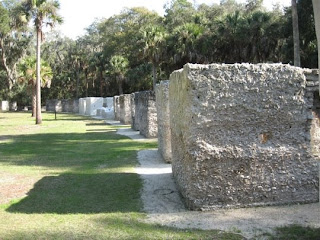
 Last post, I showed you a 2009 visit to Kingsley Plantation in the Timucuan Preserve, here in Jacksonville, Florida. Today's photos are from our visit to the plantation with out-of-town friends a couple of weeks ago on a pleasant, bright day. After viewing the ruins of the slave cabins, the buildings, and exhibits, we wandered the extensive property. I am always drawn to water, so took a trail by the river, where views of marsh grasses and small islands added charm to the view.
Last post, I showed you a 2009 visit to Kingsley Plantation in the Timucuan Preserve, here in Jacksonville, Florida. Today's photos are from our visit to the plantation with out-of-town friends a couple of weeks ago on a pleasant, bright day. After viewing the ruins of the slave cabins, the buildings, and exhibits, we wandered the extensive property. I am always drawn to water, so took a trail by the river, where views of marsh grasses and small islands added charm to the view.I took a number of photos, as I usually do in interesting coastal North Florida areas, hoping that some will provide inspiration for landscape paintings in the future. In addition to photos that might, with cropping and a few adjustments, become the basis for a painting, I take various photos to help me remember details. The bark or leaves of a particular tree, the mud at the edge of a river, a close-up of salt marsh grasses, a cloud formation, or any number of other details can provide the information I need back in the studio. Without good photo records, studio painting would be guesswork and would not result in the kind of expressive, yet representative, landscapes I like to paint. Of course, not every painter works this way, and many wonderful paintings evolve by other methods. But, for me, "making it up" does not produce the kinds of interpretations of actual locations in our beautiful area that I try to paint.
You may enjoy imagining how you would use these photos in a painting. The view of the path is intriguing, but lacks the variation in color and in lights and darks a painting needs. Guess I'd imagine more breaks in the trees on the left to add more sunny patches on the shadowed walk, then intensify the drama of the bright area where the trail curves out of sight with sunlit tree trunks and foliage. The river view has multiple possibilities; one would be to use a 6" x 12" canvas I have and paint a narrow panoramic view.
Question of the day: Do you, too, find yourself captured by a scene off the beaten path that other people might pass without noticing?
























